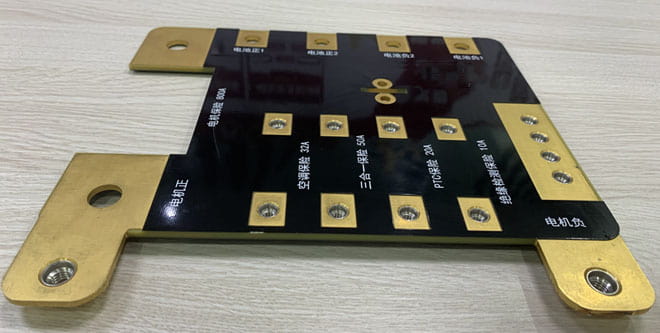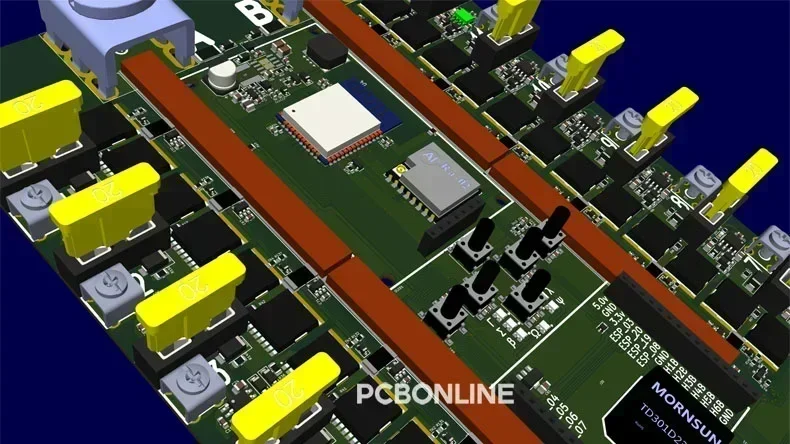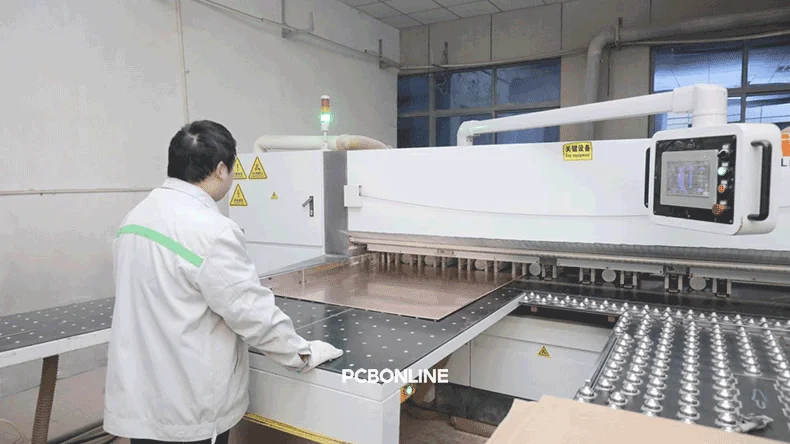Industrial printed circuit boards (PCBs) serve as the backbone of automation equipment, robotics, motor control systems, power electronics, energy management, and other mission-critical industrial applications. Unlike consumer electronics, industrial PCBs must deliver long-term reliability under high temperatures, continuous operation, vibration, heavy currents, and exposure to harsh chemicals.
As an OEM PCB manufacturer specializing in industrial controls, PCBONLINE provides one-stop manufacturing for high-reliability industrial PCBs. This article explains the characteristics of industrial-grade PCBs and the manufacturing processes to build industrial PCBs.

Characteristics of Industrial PCBs
Industrial PCBs focus on reliability, long service life, and predictable performance under stress. To build them, careful selection of materials, reasonable designs, and rigorous manufacturing processes are required.
Extended thermal stability
Industrial environments often expose PCBs to rapid temperature swings, ranging from sub-zero conditions in refrigeration to continuous high heat near motors, furnaces, and power modules. Therefore, industrial PCBs use high-Tg materials with a controlled Z-axis CTE.
- High glass transition temperature (Tg): Industrial PCBs are often high-Tg PCBs (≥170°C). High-Tg FR4 maintains mechanical stability, prevents warping, and avoids thermal degradation during long-term high-temperature operation. In contrast, Consumer FR4 typically has a Tg of about 130°C.
- Low coefficient of thermal expansion (CTE): A close CTE match between copper and laminate material is essential. We use PCB materials of a low CTE to minimize plated-through-hole (PTH) barrel cracking, maintain integrity under thermal cycling, and prevent layer delamination.
Thicker copper and reinforced vias
Industrial PCBs are often exposed to machinery vibration, shock, and mechanical stress. For this reason, industrial PCBs use thicker copper and reinforced vias to improve mechanical strength and vibration durability.

- Heavy copper (2–6 oz or more): Industrial PCBs often use a thick copper thickness to support high-current industrial loads for motor drives, power modules, and relays. It also improves heat spreading and thermal reliability. A thick-copper PCB requires an electrostatic spray solder mask process to achieve the best protection and appearance.
- Thick PCB core (2.0–3.2 mm): Industrial PCBs often use a thick copper core to increase rigidity and prevent flexing during installation and long-term operation.
- Reinforced vias: Industrial PCBs' vias are reinforced through thicker copper plating and resin-filled vias for blind/buried structures. It increases fatigue life under vibration.
Chemical and environmental resistance
Industrial equipment often faces contamination from dust, oil mist, corrosive gas, and cleaning solvents.
Industrial PCBs often apply epoxy-based solder mask for strong chemical resistance and to prevent tin whiskers and oxidation.
They also apply conformal coatings to resist moisture and corrosion.
Besides, to maintain electrical stability and prevent delamination in humid environments, the laminates used for industrial PCBs are of low moisture absorption.
High-reliability surface finish
PCBs used for long-life industrial systems require top-tier connection reliability.
For reliability, the surface finishes of industrial PCBs are ENIG (electroless nickel immersion gold) or electrolytic nickel/cold. The gold finishes deliver long-term corrosion resistance and ultra-low contact resistance.
Controlled impedance
High-speed industrial communication PCBs follow the protocols of Industrial Ethernet, Fieldbus systems, and high-speed sensor networks. Their impedance control tolerance is ±5%.
Using copper busbars
In high-power industrial applications, it's common to inlay or mount PCB busbars onto the PCB to enhance the thermal conductivity, current-carrying capability, mechanical strength, and power distribution.

- Enhanced thermal conductivity: Industrial PCBs like power modules, inverter drivers, motor control boards, and high-current DC links use copper busbars for higher thermal conductivity. PCB copper busbars act as high-capacity heat spreaders, prevent overheating, and enhance reliability under continuous load.
- Supports higher currents: Busbars can handle 50A–300A or higher currents, far beyond what copper traces can support, without excessive temperature rise.
- Improved mechanical strength: Busbars provide robust mechanical strength and structural stability. They improve PCB rigidity, reduce vibration damage in industrial machinery, and provide a solid mechanical interface for high-power connectors or terminal blocks.
- More power distribution: PCB busbars reduce resistive losses, voltage drop, and hotspots.
Thanks to the above advantages, in industrial power electronics, PCBs designed with copper busbars are used, including industrial motor drives, EV charging systems, renewable energy inverters, and battery management systems (BMS).
Manufacturing of Industrial PCBs
Industrial PCB manufacturing requires stringent process control than consumer-grade products, especially when meeting IPC Class 3 standards.

- Material selection and traceability: For industrial PCBs, we choose premium materials, such as high-Tg FR4, polyimide for rigid-flex PCBs, high-frequency laminates, and low-loss materials for communication interfaces. We also maintain material lot traceability to ensure full backward compatibility for audits and quality control.
- Vacuum lamination: The industrial PCBs manufacturing process uses vacuum lamination to remove air and volatile materials during pressing to prevent inner-layer voids and improve adhesion strength.
- Precise registration: Industrial PCB manufacturing requires AOI-assisted alignment to ensure micro-level accuracy. It is critical for fine-pitch and impedance-controlled layers.
- Precision drilling and plating: Drilling and copper plating of industrial PCB requires customized drill speeds for high-Tg materials, as they are harder and may break when drilling. Precision drilling is also important to prevent resin smear and improve plating adhesion.
- High aspect ratio plating: Industrial PCBs often require thick copper traces, so for a uniform copper distribution, PCB manufacturing requires high-aspect ratio plating and pulse plating.
- Lead-free surface finishes: No matter what surface finishes to apply, ENIG or immersion silver, they must be RoHS/REACH-compliant for environmental safety and reliability.
- Automated conformal coating: Industrial PCBs require the conformal coating spraying process to be automated for consistent film thickness for chemical and moisture protection.
- Quality assurance and testing: Industrial PCB manufacturing and assembly must follow the IPC-A-600 Class 3 and IPC-A-610 Class 3 standards. They must undergo tests and inspections 100%, including the PCBA functional test to ensure the PCBA performance, thermal stress testing (IPC-TM-650) to confirm the reliability of PTH barrels during rapid temperature changes, a microsection analysis to ensure a continuous copper plating thickness, layer alignment, and via plating.
Partner with PCBONLINE for OEM Industrial PCBs
PCBONLINE is an OEM industrial control PCB assembly manufacturer providing free DFM (design for manufacturing) and one-stop PCBA manufacturing. You can work with PCBONLINE to turn your industrial control project into successful real products.

Founded in 2005, PCBONLINE has two large advanced PCB manufacturing bases, one PCB assembly factory, an R&D team, and stable supply chains for components and materials.
PCBONLINE offers free DFM before and during PCBA prototyping to debug design defects and solve unexpected issues to ensure the success of your industrial control board, including Gerber, BOM (bill of materials), manufacturing process design, testing, IC burn-in programming, and enclosure.
PCBONLINE has dominant advantages in industrial control and IoT PCB assembly. Both require experienced manufacturers like us to provide engineering support in hardware building and even our development according to your initial idea.
Has one-stop industrial control PCB assembly capabilities, two large advanced PCB manufacturing bases, one PCB assembly factory, stable supply chains, and an R&D team.
Industrial control projects usually will finally go to the mass production stage. When your industrial control PCB assembly project goes to mass production, PCBONLINE will refund you the fees of R&D, prototyping/sampling, and offer free PCBA functional testing.
High-quality industrial control PCB assembly and final product assembly certified with IPC-A-610 Class 3, ISO 9001:2015, IATF 16949:2016, RoHS, REACH, and UL.
PCBONLINE has manufactured many successful industrial control PCB assembly projects. To get a quote for your industrial PCBs, please email info@pcbonline.com. Once you contact us, we will provide you with one-on-one engineering support.
Conclusion
Industrial PCBs require high-Tg materials, thick copper, copper busbars, advanced manufacturing, and 100% tests to ensure their reliability, meeting IPC Class 3 standards. To ensure the success of your industrial PCB project, get DFM and one-stop PCBA manufacturing services from the industrial control PCB assembly manufacturer PCBONLINE.




